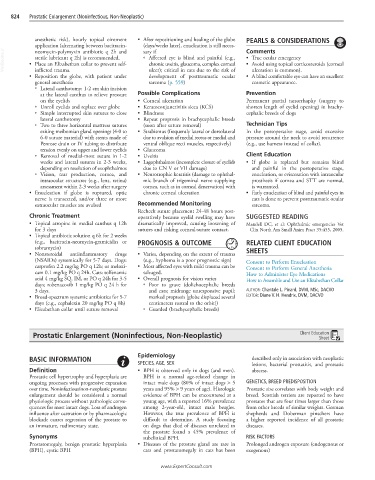Page 1638 - Cote clinical veterinary advisor dogs and cats 4th
P. 1638
824 Prostatic Enlargement (Noninfectious, Non-Neoplastic)
anesthetic risk), hourly topical ointment • After repositioning and healing of the globe PEARLS & CONSIDERATIONS
application (alternating between bacitracin- (days/weeks later), enucleation is still neces- Comments
VetBooks.ir • Place an Elizabethan collar to prevent self- ○ Affected eye is blind and painful (e.g., • True ocular emergency
sary if
neomycin-polymyxin antibiotic q 2h and
sterile lubricant q 2h) is recommended.
• Avoid using topical corticosteroids (corneal
chronic uveitis, glaucoma, complex corneal
inflicted trauma.
ulceration is common).
development of posttraumatic ocular
• Reposition the globe, with patient under ulcer); critical in cats due to the risk of • A blind comfortable eye can have an excellent
general anesthesia sarcoma (p. 559) cosmetic appearance.
○ Lateral canthotomy: 1-2 cm skin incision
at the lateral canthus to relieve pressure Possible Complications Prevention
on the eyelids • Corneal ulceration Permanent partial tarsorrhaphy (surgery to
○ Unroll eyelids and replace over globe • Keratoconjunctivitis sicca (KCS) shorten length of eyelid opening) in brachy-
○ Simple interrupted skin sutures to close • Blindness cephalic breeds of dogs
lateral canthotomy • Repeat proptosis in brachycephalic breeds
○ Two to three horizontal mattress sutures (soon after suture removal) Technician Tips
exiting meibomian gland openings (4-0 to • Strabismus (frequently lateral or dorsolateral In the postoperative stage, avoid excessive
6-0 suture material) with stents made of due to avulsion of medial rectus or medial and pressure around the neck to avoid recurrence
Penrose drain or IV tubing to distribute ventral oblique recti muscles, respectively) (e.g., use harness instead of collar).
tension evenly on upper and lower eyelids • Glaucoma
○ Removal of medial-most suture in 1-2 • Uveitis Client Education
weeks and lateral sutures in 2-3 weeks, • Lagophthalmos (incomplete closure of eyelids • If globe is replaced but remains blind
depending on resolution of exophthalmos due to CN V or VII damage) and painful in the postoperative stage,
○ Vision, tear production, cornea, and • Neurotrophic keratitis (damage to ophthal- enucleation, or evisceration with intraocular
intraocular structures (e.g., lens, retina) mic branch of trigeminal nerve supplying prosthesis if cornea and STT are normal,
assessment within 2-3 weeks after surgery cornea, such as in corneal denervation) with is warranted.
• Enucleation if globe is ruptured, optic chronic corneal ulceration • Early enucleation of blind and painful eyes in
nerve is transected, and/or three or more cats is done to prevent posttraumatic ocular
extraocular muscles are avulsed Recommended Monitoring sarcoma.
Recheck suture placement 24-48 hours post-
Chronic Treatment operatively because eyelid swelling may have SUGGESTED READING
• Topical atropine in medial canthus q 12h dramatically improved, causing loosening of Mandell DC, et al: Ophthalmic emergencies Vet
for 3 days sutures and risking corneal-suture contact. Clin North Am Small Anim Pract 35:455, 2005.
• Topical antibiotic solution q 6h for 2 weeks
(e.g., bacitracin-neomycin-gramicidin or PROGNOSIS & OUTCOME RELATED CLIENT EDUCATION
tobramycin)
• Nonsteroidal antiinflammatory drugs • Varies, depending on the extent of trauma SHEETS
(NSAIDs) systemically for 5-7 days. Dogs: (e.g., hyphema is a poor prognostic sign) Consent to Perform Enucleation
carprofen 2.2 mg/kg PO q 12h; or meloxi- • Most affected eyes with mild trauma can be Consent to Perform General Anesthesia
cam 0.1 mg/kg PO q 24h. Cats: tolfenamic salvaged. How to Administer Eye Medications
acid 4 mg/kg SQ, IM, or PO q 24h for 3-5 • Overall prognosis for vision varies How to Assemble and Use an Elizabethan Collar
days; robenacoxib 1 mg/kg PO q 24 h for ○ Poor to grave (dolichocephalic breeds
3 days. and cats; midrange unresponsive pupil; AUTHOR: Chantale L. Pinard, DVM, MSc, DACVO
• Broad-spectrum systemic antibiotics for 5-7 marked proptosis [globe displaced several EDITOR: Diane V. H. Hendrix, DVM, DACVO
days (e.g., cephalexin 20 mg/kg PO q 8h) centimeters rostral to the orbit])
• Elizabethan collar until suture removal ○ Guarded (brachycephalic breeds)
Prostatic Enlargement (Noninfectious, Non-Neoplastic) Client Education
Sheet
Epidemiology
BASIC INFORMATION described only in association with neoplastic
SPECIES, AGE, SEX lesions, bacterial prostatitis, and prostatic
Definition • BPH is observed only in dogs (and men). abscess.
Prostatic cell hypertrophy and hyperplasia are BPH is a normal age-related change in
ongoing processes with progressive expansion intact male dogs (80% of intact dogs > 5 GENETICS, BREED PREDISPOSITION
over time. Noninfectious/non-neoplastic prostate years and 95% > 9 years of age). Histologic Prostatic size correlates with body weight and
enlargement should be considered a normal evidence of BPH can be encountered at a breed. Scottish terriers are reported to have
physiologic process without pathologic conse- young age, with a reported 16% prevalence prostates that are four times larger than those
quences for most intact dogs. Loss of androgen among 2-year-old, intact male beagles. from other breeds of similar weights. German
influence after castration or by pharmacologic However, the true prevalence of BPH is shepherds and Doberman pinschers have
blockade causes regression of the prostate to difficult to determine. A study focusing a higher reported incidence of all prostatic
an immature, rudimentary state. on dogs that died of diseases unrelated to diseases.
the prostate found a 45% prevalence of
Synonyms subclinical BPH. RISK FACTORS
Prostatomegaly, benign prostatic hyperplasia • Diseases of the prostate gland are rare in Prolonged androgen exposure (endogenous or
(BPH), cystic BPH cats and prostatomegaly in cats has been exogenous)
www.ExpertConsult.com

